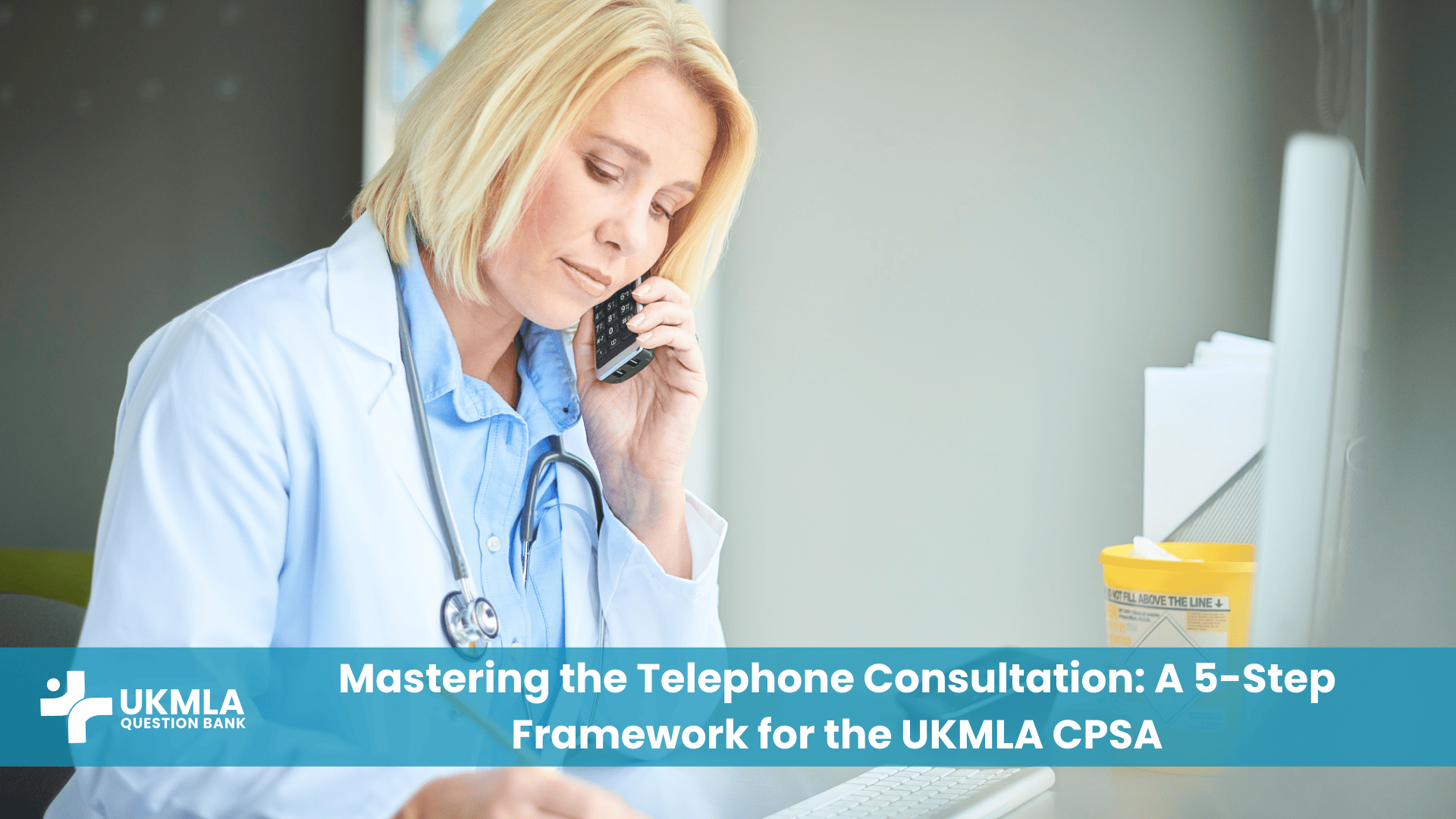Introduction
Mastering the most challenging scenarios for UKMLA CPSA is a critical step in your preparation, moving beyond clinical knowledge into the art of professional practice. The Clinical and Professional Skills Assessment (CPSA) is specifically designed to test your resilience, empathy, and ability to maintain patient safety under pressure. While knowing the steps of a clinical examination is important, how you handle a patient who is angry, distressed, or refusing care is what truly demonstrates your readiness to be a doctor.
This guide is designed to give you the tools and confidence to excel in these difficult stations. We will provide a universal framework for managing any challenging encounter and then walk through the 5 most common scenarios you are likely to face. By learning to apply these structured communication techniques, you can transform these intimidating stations into an opportunity to showcase your core professional skills.
Table of Contents
ToggleA Universal Framework for Managing Difficult Encounters
When faced with a difficult situation, it’s easy to feel flustered. The key is to have a simple, repeatable framework. The LEAP framework is an excellent tool for structuring your response.
The “LEAP” Framework: Listen, Empathise, Acknowledge, Plan
Listen: Your first and most important job is to listen. Let the patient speak without interruption. Often, a patient’s frustration comes from feeling unheard. Use active listening techniques: maintain eye contact, nod, and use verbal encouragers like “I see” or “go on.” The goal is to understand the true source of their emotion.
Empathise: Once you have listened, you must show that you have understood their feelings. This is not the same as agreeing with them. It is about validating their emotion. Use clear, empathetic statements.
Acknowledge: After showing empathy, summarise and acknowledge their core concern. This proves you have been listening and helps to de-escalate the situation by confirming you are both on the same page.
Plan: Only after you have listened, empathised, and acknowledged should you move to problem-solving. Work collaboratively with the patient to formulate a clear and safe plan forward. This turns a confrontation into a partnership.
This entire process is underpinned by the principles of professionalism set out in the GMC’s “Good Medical Practice” guidance, which is the gold standard for your conduct.
The 5 Most Common Challenging Scenarios for UKMLA CPSA
Let’s apply the LEAP framework to the five most common and challenging scenarios for UKMLA CPSA.
Scenario 1: The Angry or Frustrated Patient
The Challenge: You enter a station where an actor is playing a patient who is angry about a long wait, a perceived mistake, or a lack of information. Your task is to de-escalate the situation while ensuring you can still address the clinical issue safely.
Applying the Framework:
Listen: Do not become defensive. Let them vent their frustration completely. Your silence and attentive posture are your most powerful tools here.
Empathise: Use phrases like, “I can see how incredibly frustrating this situation has been for you.” or “It sounds like you’ve had a very difficult time, and I can understand why you feel angry.”
Acknowledge: Summarise their specific complaint. “So, just to be clear, you’ve been waiting for three hours for your test results, and nobody has come to update you. That is completely unacceptable, and I am very sorry that has happened.”
Plan: Propose a clear, immediate action. “My absolute priority right now is to find out what is happening with your results. I am going to go and speak to the lab right now and will come back to you in the next 10 minutes with an update. Is that okay?”
Clinical Pearl: “You cannot reason with an angry person. You must address the emotion before you can address the problem. Acknowledge the feeling first, and the facts can follow.”
Scenario 2: The Anxious or Distressed Patient
The Challenge: The patient is visibly anxious, perhaps about an upcoming procedure, a new symptom, or test results. Your goal is to build rapport and provide reassurance without giving false hope or dismissing their valid concerns.
Applying the Framework:
Listen: Ask open-ended questions to explore their fears. “Tell me a bit more about what’s on your mind.” or “What is it that’s worrying you the most?”
Empathise: Validate their anxiety. “It’s completely normal to feel anxious in a situation like this. Many people feel the same way.”
Acknowledge: Show you’ve heard their specific worry. “So, you’re particularly worried about the side effects of the medication I’ve mentioned.”
Plan: Provide clear information and a plan to manage their anxiety. “Let’s go through those side effects one by one. I can explain what we can do to manage them if they occur. We can also talk about some breathing exercises that might help right now.”
Scenario 3: Breaking Bad News
The Challenge: You have to deliver life-altering information, such as a new cancer diagnosis or a poor prognosis, in a clear, sensitive, and supportive manner.
Applying the Framework: This scenario requires a more structured approach, often integrating the LEAP framework with a protocol like SPIKES.
Setting & Perception: First, ensure you are in a private, quiet setting. Then, use the “ask before you tell” approach: “Before we talk about the results of your scan, can you tell me what you understand about why we did it?”
Invitation & Knowledge: Ask for permission to share the news. “Are you ready to talk about the results now?” Then, give a “warning shot” before delivering the news clearly and simply, without medical jargon. “I’m afraid the news is not what we had hoped for.”
Emotions & Empathy (The “E” in LEAP): This is the most critical step. After delivering the news, stop talking. Allow for silence. Let the patient react. Your job is to respond to their emotion with empathy. “I know this is a huge shock.” or “This is not the news you wanted to hear, and I am so sorry.”
Strategy & Summary (The “P” in LEAP): Once the initial emotional storm has passed, you can begin to formulate a plan. “When you’re ready, we can talk about what the next steps will be. The most important thing to know is that we have a plan, and we will be here to support you.”
For more on this, our guide on Palliative Care Principles for UKMLA is highly relevant.
Scenario 4: Dealing with a Colleague’s Error
The Challenge: A patient tells you they believe a mistake has been made by another doctor or nurse. Your task is to be honest and uphold the Duty of Candour without inappropriately blaming colleagues or undermining the patient’s trust in the healthcare system.
Applying the Framework:
Listen: Listen carefully to the patient’s account of what happened and what their specific concerns are. Do not interrupt or try to defend your colleague.
Empathise: Acknowledge the distress this has caused. “It sounds like that was a very frightening and confusing experience for you, and I’m very sorry you went through that.”
Acknowledge: State the facts as you understand them without apportioning blame. “What I can see from the notes is that you were prescribed penicillin, and that you have a known allergy to it. This should not have happened.”
Plan: Your plan must focus on two things: immediate safety and the process for addressing the error. “My first priority is to make sure you are safe now. I’m going to check your observations and make sure you are stable. Then, I need to let you know that we take incidents like this very seriously. I will be reporting this immediately so we can investigate fully how it happened and make sure it doesn’t happen to anyone else. I will ensure a senior doctor comes to speak with you to explain the process.”
This approach is central to the principles of professionalism and patient safety.
Scenario 5: The Patient Who Refuses Treatment
The Challenge: A patient with capacity is refusing a treatment that you believe is in their best interests. Your task is to respect their autonomy while ensuring their decision is fully informed.
Applying the Framework:
Listen: Explore why they are refusing. What are their specific fears or beliefs? “Can you help me understand your reasons for not wanting the blood transfusion?”
Empathise & Acknowledge: Validate their right to decide. “I understand that this is your decision to make, and I respect that completely. My role is to make sure you have all the information you need to make the best decision for you.”
Plan: The plan here is about ensuring they have capacity and are fully informed.
Assess Capacity: Gently check that they can understand, retain, weigh, and communicate their decision.
Provide Information: Clearly and calmly explain the potential benefits of the treatment and the potential consequences of refusing it.
Explore Alternatives: Discuss if there are any alternative treatments that might be more acceptable to them.
Document Thoroughly: If they still refuse, you must respect their decision and document the entire conversation in detail.
This is a classic test of the principles in our guide to Medical Ethics and Law for UKMLA.
How Your Performance is Assessed in These Stations
In these stations, the examiner is assessing you against the four CPSA domains.
A Note on Assessment: “Your ability to demonstrate empathy is not just a ‘nice to have’—it is a core clinical skill that is explicitly marked. In a challenging station, showing you can connect with the patient on a human level is as important as your clinical knowledge.”
Data Gathering: Are you asking open-ended questions to understand the patient’s perspective?
Clinical Management: Is your proposed plan safe and appropriate?
Interpersonal Skills: Are you listening actively? Are you using empathetic language? Is your non-verbal communication (eye contact, posture) appropriate?
Professionalism & Patient Safety: Are you maintaining a calm and professional demeanour? Are you prioritising the patient’s safety and respecting their autonomy?
Frequently Asked Questions (FAQ): Challenging Scenarios
Your personal safety is the priority. Maintain a calm tone and do not shout back. You can say, “I really want to help you, but I cannot do that if you are shouting at me. If you continue, I will have to end this consultation for both of our safety.” If you feel threatened, state that you are leaving to get help and do so.
The most powerful thing you can do is stop talking. Pass them a box of tissues and wait quietly. This shows respect for their emotion. You can then use a simple, empathetic phrase like, “Take all the time you need.”
Honesty is the best policy. Never guess or make something up. Say, “That is an excellent question, and I want to make sure I give you the correct information. I’m not 100% sure of the answer, so I am going to go and confirm with my senior consultant and come straight back to you.” This is safe, honest, and professional.
Acknowledge the family member’s concern, but always remember that your primary duty is to the patient. You can say, “I can see this is very upsetting for you. My priority right now is to speak with [Patient’s Name] to understand their perspective. Perhaps we can all talk together afterwards.”
Sympathy is feeling sorry for someone (“I’m so sorry this happened to you”). Empathy is showing you understand how they are feeling (“It sounds like this has been an incredibly frustrating experience for you”). Empathy is more powerful as it validates their specific emotion.
Use the “ICE” (Ideas, Concerns, Expectations) framework. Explore why they want it. Then, explain the reasoning clearly. “I understand you were hoping for antibiotics to get better faster. My concern is that antibiotics don’t work for viruses like this one, and they can have side effects. The best plan is…”
Your duty of confidentiality is to the patient. You should respect their wish, unless withholding the information puts someone else at risk of serious harm. You can reassure the patient: “The information you share with me is confidential, and I will not discuss it with your family without your permission.”
Practice. The more you practice these scenarios with a framework like LEAP, the more automatic your response will become. This frees up your mental energy to focus on the specifics of the station.
Jumping to the “Plan” stage too early. Most students are trained to be problem-solvers, so their instinct is to immediately offer a solution. In these stations, you must force yourself to Listen, Empathise, and Acknowledge first.
Role-playing with friends, family, or study partners is the best way. Use scenarios from a high-quality UKMLA question bank to work through dozens of SBAs on palliative care, ethics, and communication to see how these concepts are tested in practice.
Conclusion
Ultimately, success in the most challenging scenarios for UKMLA CPSA comes down to combining a systematic communication strategy with genuine compassion. Frameworks like LEAP are not scripts to be memorised, but tools to ensure you remain calm, professional, and patient-centred, even when under pressure. By practicing these scenarios, you are not just preparing for an exam; you are building the core professional skills that will define you as a safe, empathetic, and trustworthy doctor for the rest of your career.




